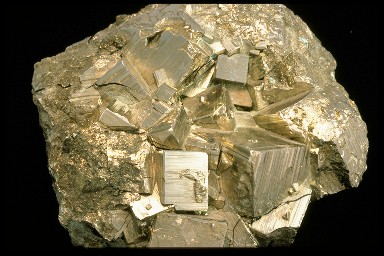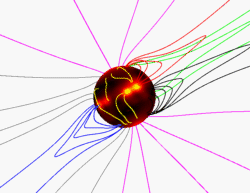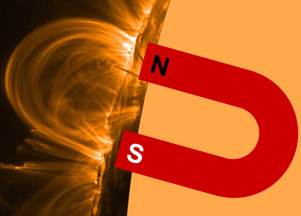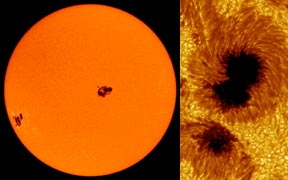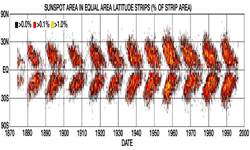Animation courtesy of SOHO (ESA & NASA).
Magnetic Field Lines Get Tangled as Sun Rotates
The Sun is not solid. It is a huge ball of plasma, which is a lot like a gas. Some parts of the Sun spin faster than other parts. Places near the Sun's equator spin fastest. The Sun's poles spin more slowly. This movie shows the middle of the Sun spinning faster than the poles. The Sun has a magnetic field. The blue lines in this movie are magnetic field lines. At the start, the magnetic field lines are nice smooth curves. After a while, the lines get stretched by the fast-spinning equator. Later, the magnetic field gets stretched so far that it becomes a tangled mess.
The tangles can make very strong magnetic fields. Areas with strong magnetism often have sunspots. Sometimes they make solar "storms", like solar flares and coronal mass ejections (CMEs). When there are lots of tangles, there are lots of sunspots. That happens about once every 11 years. When the magnetic field is mostly smooth, there are hardly any sunspots. This cycle of few tangles (and few sunspots) followed by lots of tangles and sunspots is repeated every 11 years or so. Scientists call it the sunspot cycle.
Every 11 years, at the end of a sunspot cycle, the magnetic poles of the Sun switch places. The North Magnetic Pole goes to the Sun's South Pole, and vice versa. It actually takes two whole sunspot cycles (about 22 years) for the Sun's magnetic poles to get back to where they started.
Right-click (Windows) or Option-click (Mac) on any of the following links to download a copy of this video in QuickTime or MPEG formats: large (3.7 MB) QuickTime, small (919 KB) QuickTime, large (2 MB) MPEG, or small (714 KB) MPEG.






